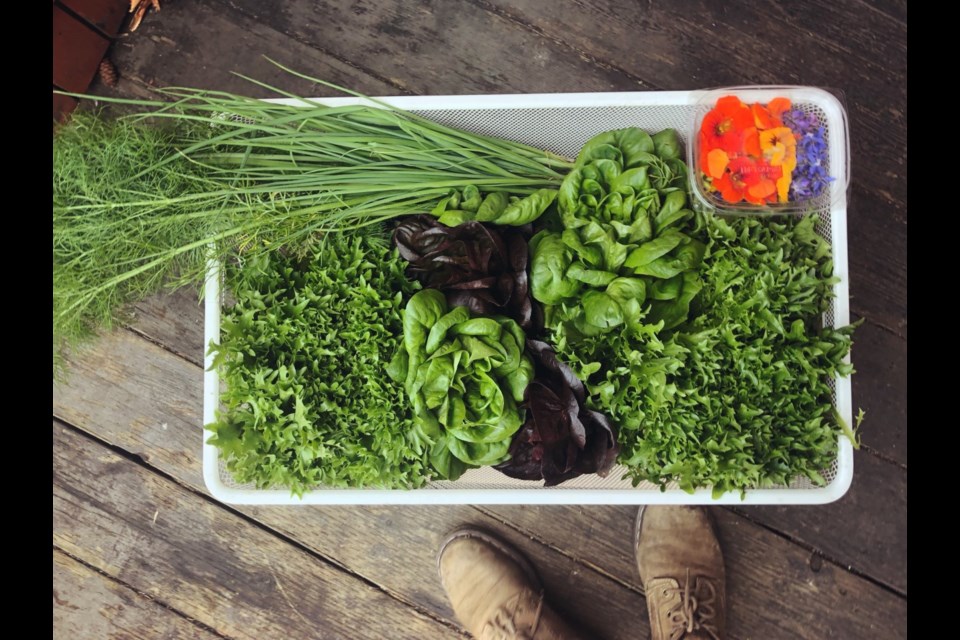BOW VALLEY – Have you ever wanted to grow your own garden, but had no clue how to in a mountain climate?
Well, get your green thumbs ready as local urban farmer Brooke Williams has some tips for you.
Introducing a garden design and building service, farmer Brooke said the backyard vegetable garden idea was inspired amid the COVID-19 pandemic when local grocery shelves started going bare.
"It kind of came out of COVID times," Williams said with a laugh.
"A lot of people are into [the idea of] gardening, but don't know where to start."
As the province shuttered non-essential business storefronts earlier this year and people started panic buying – trying to stock up their fridges and pantries in an effort to reduce going to the shops – shelves started to have less and less produce, which in turn motivated Williams to put her urban agriculture background to use.
"I know how to garden in urban areas and I was working in the [local] greenhouse and people had questions," she said.
Most initial interactions the urban farmer had with Bow Valley locals included a general discouragement of being able to grow anything in the mountains, along with a lack of confidence in their own gardening abilities.
"I think people in general are discouraged to grow – I've had many people say you can't grow anything here, so being able to be confident and putting that first seed in the soil ... you have to start there," Williams said.
"Lots of people say they don't have a green thumb, but it is all learned and it is all an outdoor classroom."
Working with the Town of Canmore and Town of Banff, farmer Brooke filmed and released a YouTube video on April 27, titled Intro to Growing your Own Garden in the Bow Valley.
In the short almost three minute clip, the urban farmer gives a quick history lesson about Victory Gardens and how after the First World War almost 40 per cent of North Americans were growing some, most, or all of their own food – a percentage that has reduced to one per cent, according to Williams, in recent years.
"After [the First World War] the governments promoted homeowners to grow their own food, grow their lawns and gardens and talk about food systems and talk about why growing your own food is rewarding," Williams said.
But over the years, the shift to grow your own food has changed, as the green revolution – mass-producing agriculture – was introduced in the 1950-60s, people started to rely more and more on grocery stores. Then the pandemic hit.
As produce shelves went bare and with extra time on our hands, now is the perfect time to learn to learn to grow, Williams said.
While the Bow Valley is within a wildlife corridor and there are bylaws around attracting wildlife – the only mention of prohibited growing in Canmore's wildlife attractant bylaw is fruit trees.
"No person or owner of a parcel of land shall permit a wildlife attractant, including but not limited to fruit from a crabapple or mountain ash tree or shepherdia (buffaloberry) bush, or otherwise located on a parcel of land, to accumulate on the tree, bush or ground," the bylaw states.
So, what can you grow in the mountains?
A lot.
The Bow Valley is in the plant hardiness zone three, meaning mountain growing is ideal for hearty vegetables such as broccoli, brussel sprouts, Swiss chard and kale; leafy vegetables and salad greens including arugula, spinach, orach or mountain spinach, bok choy, collard greens, lettuce heads, baby lettuce and baby kale; herbs such as chives, green onion, dill, rosemary, thyme, fennel, and mint; legumes such as shelling peas, snap peas, bush beans and poles beans, and several root vegetables including beets, carrots, radishes, turnips and parsnips.
With options for residents in basements, apartments, balconies and yards – farmer Brooke said you can grow anywhere as long as you have the right tools.
"If you have balcony space you can use pallets, line it with [garden] fabric and soil. Or you can use milk crates, or take recycled water bottles and hang them along a balcony, or fence or you can even use rain gutters from the store," Williams said.
With endless opportunities for those looking to get their green thumb on, other pieces of advice farmer Brooke wanted to share was to keep in mind that gardens should be close to a water source, ideally fenced if wildlife frequents your yard and if the garden will be in the south part of the home or a spot that is south-facing it is also ideal – but if a south-spot is not possible, no worries as there are still lots of crops that thrive in the shade.
"No matter what kind of living situation you have, there is always a way to start growing," farmer Brooke said.
For more information on how to get your balcony or backyard garden started, talk to local greenhouses or garden centres or reach out to farmer Brooke for a personal design at [email protected].




